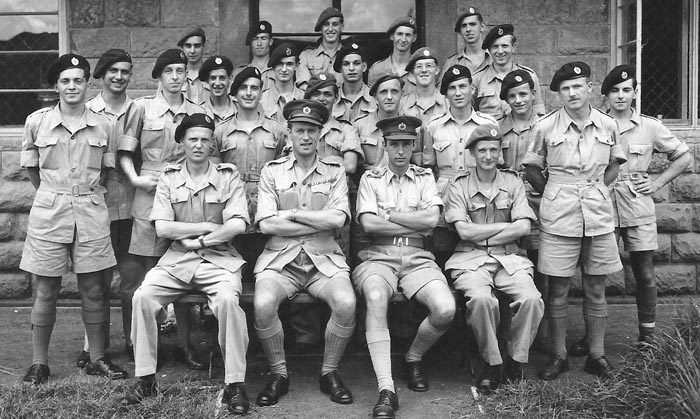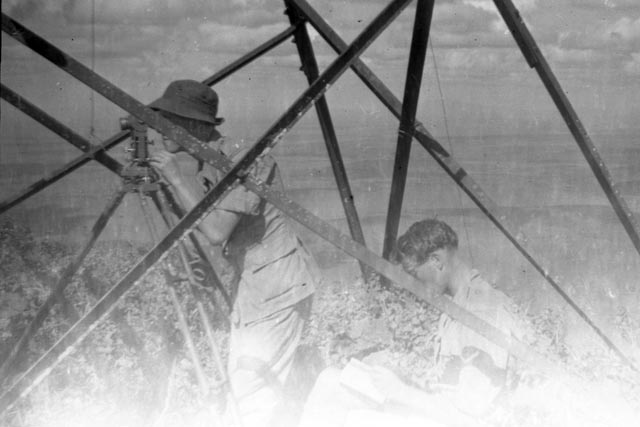
6 RASLS in Nairobi

The photo is of 6 RASLS RE, EEastleigh, Nairobi 30 November 1951
Back row: Hinton, Barker, Wilmore, Beddow, O'Hare.
Third row: L/Cpl Reeves, Done, Fowler, Deverson, Peeke, ?????
Second row: L/Cpl Coughtrey, Barnsdall, Furness, Emmott, L/Cpl Edwards, L/Cpl Thomas, Lane, Cpl Whittaker, ????.
Front row: Sgt Watson, Major Hellings, 2/Lt Garde-Hansen, Cpl Hall
Any help with the missing names would be appreciated.
My 10 months with 6 RASLS RE
I and three other National Service sappers joined 6 Radar Air Survey Liaison Section at Takoradi in what was then the Gold Coast in West Africa on 26 January 1951. This was almost exactly a year after I had been at 3 TRRE at Guillemont Barracks to do basic field engineer training, then trained as a trigonometrical surveyor at SMS Hermitage, spent 2 cold January weeks at Barton Stacey, been flown in a chartered civilian Vickers Viking to Accra, with an overnight stop at Gibraltar, and picked up from Accra the following day by 82 Squadron RAF Dakota.
We four new boys soon got used to the routine of starting work early and normally having the afternoons off. This enabled us to go to the beach where I found the sea temperature to my liking and soon learnt to swim. We got used to having a 'boy' to do our chores and banana fritters with our evening meal, but took a little longer, despite the ceiling loofahs, to get used to sleeping under a mosquito net in the sweltering night temperatures at sea level only 5 deg north of the Equator. We were allowed to buy RAF shoes and long socks from the squadron stores and had our shorts shortened to the length worn by our RAF colleagues. This meant that the only difference in our appearance from the airmen was then the colour of our berets and the fact we had no eagle shoulder badges. The Section even paraded on the weekly squadron parades as no.4 flight and if the CO, a wing-commander, wasn't present our OC took the parade because as an army major he outranked the 2 or 3 squadron-leaders on the squadron.
We were immediately introduced to the work of the section and I was soon drawing up flying charts for areas to be surveyed in Sierra Leone. Also laying out survey photographs to check that the quality was suitable for map making, as well as co-ordinating the radar scans with the photographs. We worked on Saturday mornings but on Sundays there were occasional excursions along the coast. During April we were all moved to RAF Eastleigh in Nairobi by RAF Valettas of Transport Command. This was not without incident as the aircraft I was in was forced to stay at Kano for 36 hours with an undercarriage problem, landed at Maiduguri with engine trouble, spent a day at El Fasher with propeller trouble and finally had to wait at Juba in order to follow another aircraft because of a compass problem. At Eastleigh we were in a purpose-built barrack block and had to get used to again doing our own chores. However the night temperatures were better for sleeping because although only 1 deg south of the Equator we were now well inland at over 5,000 ft. We now worked all day and I prepared a number of flying charts. Sundays had occasional excursions, including one to Lake Naivasha which meant going down into the Rift Valley, giving some wonderful views. From our quarters we could see Mount Kenya to the north and Mount Kilimanjaro to the south.
At the end of May I was sent on detachment to Livingstone in the then Northern Rhodesia as briefing sapper with the squadron detachment. I had an office in the airport control tower and my job was basically to keep the navigators' charts up-dated and report on progress by signals back to Eastleigh. I used to meet the Lancasters when they returned from a sortie, collect the charts, prepare my signal, update the charts from signals received from base and then put the updated charts into the aircraft for the next day's sortie. Each Thursday I sent a written report to base via the squadron's weekly Dakota flight from Eastleigh which also brought me any new charts. Although we worked a 7 day week, there were days when for various reasons no flying took place and visits were possible to the nearby Victoria Falls. I also made contact with the local Survey Department and arranged some special visual survey flights for them. Livingstone was a stop on the London- Johannesburg air route and a highlight of aircraft arrivals was that of Comet G-ALZK on a proving flight before it went into service with BOAC.
Late in September, shortly after my 20th birthday, the work at Livingstone was finished and I
returned to Eastleigh non-stop in one of the Lancasters. After four months of again having someone
to do my chores, I once again I had to get used to barrack life and looking after myself. I was now
mainly given the job of correlating the radar readings with the photographs but we also did some
outdoor survey work during which we had to carry a theodolite up the Ngong Hills and take
observations from the survey point at just over 8,000 ft. One day several of us acted as passengers
in an early Vickers Viscount while it carried out trial manoeuvres from a high altitude airfield
before they went into service.
I left 6 RASLS on 30 November to travel overnight by train to Mombassa where I boarded HMT
Empire Medway for the journey home. My experience when I was a Sea Cadet helped when it
came to slinging the hammocks in which we slept. After a trip of 38 days via Dar-es Salaam,
Mauritius and Aden, with Christmas in the Great Bitter Lake (with a fire in the boiler room) and
New Year's Eve in the Mediterranean, we eventually docked in Southampton opposite the Queen
Elizabeth. Then, after another two cold January weeks at Barton Stacey, I again became a civilian,
but with great memories.

Bruce observing in the Ngong Hills
With thanks to Bruce Peeke for this contribution.